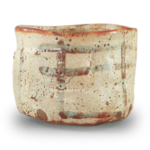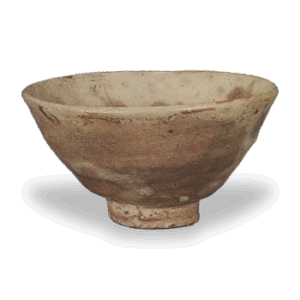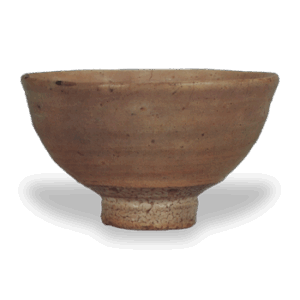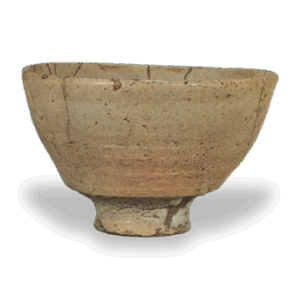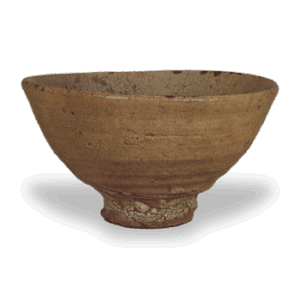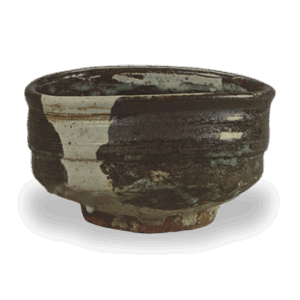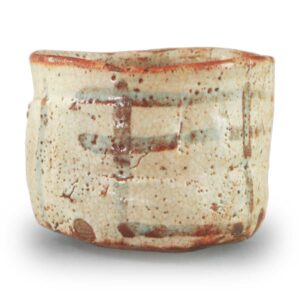
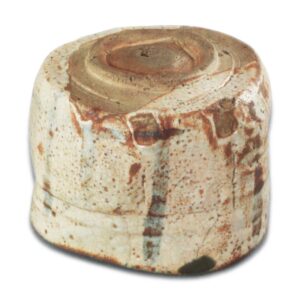
National Treasure
Height: 9.2-9.6cm
Diameter: 10.4-11.7cm
Outer diameter of foot ring: 6.3cm
Height of foot ring: 0.4cm
This is a famous bowl that has long been renowned as the best of Shino ware. The name “Uka-gaki” is said to have been given by Katagiri Sekishu, who likened the iron-painted pattern on the body to a field of blooming Japanese anemones.
The clay is a rough clay commonly known as mugusa-do, and has an eggshell-like color. This clay is unique, not found in Seto or Mino, and is a warm, soft, familiar clay.
The shape is almost straight, but with two large ridges on the top and bottom, giving it a different look. The rim is thick and full, and the contrast between the thick and thin parts is beautiful. The mouth is also interesting in that one side is straight, while the other is slightly curved. The foot is roughly scraped with a wooden spatula, and although it is short, it has a dignified feel.
The Shino glaze, which is mainly made from feldspar, is thickly applied both inside and out, but it was not applied with a brush, but rather by dipping the brush into the glaze and applying it in one go. The finger marks and foot ring are exposed, but the inside is covered in thick Shino glaze.
When you look at the top of the mouth, it is not a perfect circle, but rather a rounded triangle, and although it looks heavy, it is actually a more compact teacup than it looks in the photo, and is more like a small teacup.
It has a good shape, good workmanship, and a beautiful glaze, but the best thing about this teacup is the red, scorched color of the glaze, which is clearly visible even on the part of the base that is exposed. I have never seen such a beautiful Shino ware with such a beautiful red color around the rim. The red color is created when the glaze is thin and the small amount of iron contained in the clay burns, but it is difficult to control the heat, as it will disappear if the fire is too weak or too strong.
There are vertical and horizontal lines added under the glaze on the body using iron pigment called “oniita” in the Seto-Mino region, but it is doubtful whether they were originally drawn with the fence in mind. There are various abstract patterns in Shino and Oribe, and they should be considered as patterns before patterns.
Uka-gaki is the most famous Shino bowl, but it is difficult to say exactly when and where it was made. Judging from the style and the plainness of the design, it is thought to have been made around the Tensho and Bunroku periods. The remains of kilns where Shino ware was made in Mino have been discovered in over 40 locations, including Kuguri Okaya and Ohira in Kani Town, Hisajiri, Takane, Otomi, Jorinji, Tsumaki, Sogi, and Mizunami City’s Tō , and the kiln that produced the best Shino ware in Mino is said to be the Muta-do kiln in Kuguri-okaya. Arakawa Toyozo collected shards at the Muta-do kiln site that were exactly like those of the Ukabagari, so it is thought that the Ukabagari was made at Muta-do in Okaya in the Tensho and Bunroku periods.
Fukuro Ichimatsu Sarasaori
Inner box paulownia wood, lid with inscription “Uka-gaki” Katagiri Sekishu
Lid with inscription “Yamasato no ono no nakano kakinokami no nakatsumichi yukifumiwake shikokoso sure”
Outer box: oak
It is said that this tea caddy was originally owned by the wealthy merchant family of Fuyuki in Edo, and was passed on to Kinosuke Yamada (Denan) in Osaka at the beginning of the Meiji era. In 1890, the Muromachi Mitsui family purchased it for the then-unprecedented sum of 1,000 yen. It was designated as a national treasure in 1959.

